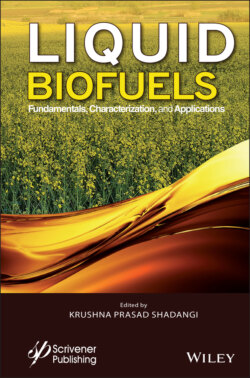Читать книгу Liquid Biofuels - Группа авторов - Страница 24
1.4.1 Pyrolysis and Types of the Pyrolysis Processes
ОглавлениеPyrolysis is the most basic thermochemical conversion process used to convert biomass into more valuable fuel. Pyrolysis is defined as the heat degradation process of biomass in an oxygen-free environment. As a result of the pyrolysis process, hydrocarbon-rich gas, oil-like liquid and carbon-rich solid product are obtained. The amount of gas, liquid and solid products obtained as a result of pyrolysis depends on the applied pyrolysis method and operating conditions. Pyrolysis time and temperature are the most effective parameters on product yield and product variety. Various pyrolysis methods are applied depending on the product desired to be obtained. Pyrolysis processes can be grouped as “slow” and “fast” in general terms depending on the working conditions. Pyrolysis methods and conditions are given in Table 1.1. Solid, liquid and gaseous fuels are produced as a result of thermal degradation of the biomass in an environment free of air or any reactance. Thermal decomposition is called carbonization if the solid product yield is maximized. The main reaction from the pyrolysis of biomass is the separation of water from the carbohydrate compound as follows [47].
(1.1)
Table 1.1 Pyrolysis processes for different biomass.
| Biomass | Catalyst | Temperature (°C) | Pressure (atm) | Biochar yield (%) | Biofuel yield (%) | Reference |
|---|---|---|---|---|---|---|
| Mesue ferra seed oil | Na2CO3 | 500-600 | 1 | 17.5 | 66 | [49] |
| Canola oil | HZSM-5 | 500 | 1 | 16.4 | 49.6 | [50] |
| C. inophyllum | KOH | 50 | NA | NA | 66.5 | [51] |
| Rise husk | KOH | 700 | 1 | 21 | 39 | [52] |
| Waste clay oil | CaO | 450 | NA | 23 | 72 | [53] |
| Rice straw & sugarcane | HZMN-5 | 500 | NA | 29.7 | 26.1 | [54] |
| Microcrystalline cellulose | NaY | 30-950 | N2 atm | 19 | 48 | [55] |
| Grape seeds | CaO | 550 | NA | 42.5 | 38.5 | [56] |
| Ajjwa date seed | Ni3Fe | 500 | 10 bar H2 | 15.8 | 58.1 | [57] |
NA = not available
As a result of pyrolysis of lignocellulosic solid wastes, three main products are obtained. These are semi-coking solid product (char), oil and gas as seen in Figure 1.2. As a result of pyrolysis of cellulose, char and active cellulose are obtained, the products of active cellulose which are not used as a result of biofuel production which are separated. Wastes can be converted into solid, liquid and gaseous products with the pyrolysis process. The composition and proportions of these products largely depend on the type of raw material and reaction conditions. During pyrolysis of solid wastes, a wide variety and quite complex reactions occur in series and parallel. These complex reactions occur because the breakdown of cellulose, hemicellulose and lignin in the biomass content forms different products [48].
In the pyrolysis process, the most important process variables can be considered as heating speed, temperature and duration of stay. Those variables have the effect of reactor type and particle size on the heating speed. By using any type of reactor, if the particle size is increased, thermal conductivity decreases in the plant structure, heating rate decreases in the particle and changes in product yields occur. For each selected particle size, the reactor type acts on the mechanism of heat transfer. In other words, radiation, convection and conduction mechanisms vary depending on the type of the reactor [46].
Heating of biomass at low temperatures, long gas and solid retention time are called slow or conventional pyrolysis. Depending on the system, the heating rate is in the range of 0.1–2 °C per second and commonly the pyrolysis temperature is about 500 °C. The retention time of the gas can vary from 5 seconds to minutes or days, depending on the biomass. With conventional pyrolysis, approximately equal amounts of gas, liquid and solid products are obtained [47].
Figure 1.2 Multistep collective mechanism in the degradation of cellulose [47].
Fast pyrolysis is a high-temperature process in which biomass is rapidly heated in an oxygen-free environment. Heating rate is in the range of 200 and 105 °C/s and pyrolysis temperature is generally higher than 550 °C. The liquid obtained as a result of fast pyrolysis constitutes approximately 70-80% of the biomass. Fast pyrolysis is the most preferred pyrolysis method today for the production of liquid products with features such as low cost, easier transportation and storage [48].
